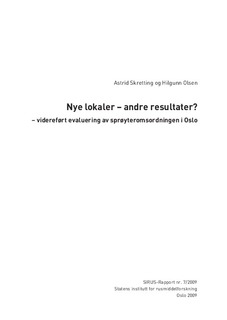Nye lokaler – andre resultater?Videreført evaluering av sprøyteromsordningen i Oslo
Research report
Permanent lenke
http://hdl.handle.net/11250/276054Utgivelsesdato
2009Metadata
Vis full innførselSamlinger
Originalversjon
SIRUS-rapport. 71 p. Statens institutt for rusmiddelforskning, 2009Sammendrag
Nye lokalerOslo kommune åpnet sprøyterom i Tollbugata 3 i januar 2005. Etter en tids drift ble det tydelig at lokalene var lite egnet til formålet, og 1. juli 2007 flyttet sprøyterommet til en brakkerigg i Prindsenkvartalet i Storgata 36.
Ny evalueringDen oppfølgende evalueringen er gjort på samme måte som den som ble levert i 2007 og gir en vurdering av om sprøyterommet, slik det fungerer i dag, innfrir formålene som ble satt i lov og forskrift. Oslo kommune ba også om en ”kost-nytte” vurdering av tilbudet.
ForbedringerDe ansattes situasjon er blitt langt bedre i nye lokaler, og brukerne gir også uttrykk for at de synes tilbudet har blitt bedre. Dette har ført til bedre trivsel for både ansatte og brukere. Det har vært en økning i helse- og sosialfaglig oppfølging av brukerne. Sårbehandling og samtaler er det som oftest går igjen.
DilemmaerFlere av dilemmaene som ble vurdert i den foregående evalueringen, er imidlertid fortsatt aktuelle. Ordningen omfatter fremdeles bare injisering av heroin, selv om røyking av stoffet er langt mindre helseskadelig. Omfanget av injisering i hals og lyske har økt, da dette medfører økt risiko for helseskade er det et dilemma hvorvidt sprøyterommet skal tillate slik injisering.
Når det gjelder de ansattes meldeplikt til barnevern og sosialtjeneste, ser det nå ut til å være avklart at denne skal overholdes slik det fremkommer i helsepersonelloven. Tidligere ble det også opplevd som et dilemma at psykisk syke brukere ikke alltid kunne bruke sprøyterommet fordi de ikke greide å innordne seg reglene. Dette problemet er langt på vei løst med nye og større lokaler som bedre ivaretar de ansattes sikkerhet, samtidig som det gir brukerne mer armslag.
”Kost-nytte”Kost-nyttevurderingen av sprøyteromstilbudet blir i evalueringen vurdert ut fra om de oppsatte formålene med ordningen kan sies å være nådd, selv om disse ikke alltid er målbare. Det må kunne sies at tilbudet bidrar til økt verdighet for den aktuelle målgruppen, både på et individuelt og på et overordnet nivå. Sprøyterommet har også bidratt til økt mulighet for helse- og sosialfaglig oppfølging, og trolig også til bedre sprøytehygiene. he new premises are satisfactory. Staff security is well attended to. Operating costshave virtually doubled since the injecting room moved to a new home, however.Higher outlays must be seen in light of the depreciation of the new premises.Consistent with the findings of the former evaluation, frequency of use byregistered clients varies widely. The ‘frequently’ percentage (on average 6 or morevisits per month) rose slightly, but so did the ‘rarely’ category (0−2 visits per monthon average). A detailed examination of the ten clients with the highest visitingfrequency reveals, all the same, large fluctuations from month to month.The amount of heroin the users report to inject shows more or less the samedistribution as at the former evaluation. Percentage of injections in the groin wasslightly higher compared the first two years of operations.Again compared with that period, the move to new premises has not causedproblems in the sense of the police «chasing» injecting room clients away ormaking it difficult to run the Oslo-injecting facility in any way.As was said in connection with the last evaluation, the supervised drug injectionscheme can be said to have promoted the dignity of the group in question, bothgenerally and for the individual. Although it is impossible to operationalise dignityas a concept in a measurable way, one can say that the injecting room communicatesan acknowledgement of injecting drug users’ basic human value and need of help.For the clients, the services and contact with staff doubtless go some way tounderpinning a sense of dignity. Working conditions at the new premises are better,increasing staff and client satisfaction, which again can be said to help clients feelmore valued than was the case in the old facility.After the move to the new premises, somatic and psycho-social health matters wereraised in 14 per cent of all visits, while the corresponding percentage during thefirst two operating years was 8 per cent. Treatment of wounds and consultations with staff are the most frequent forms of assistance. Although the rise can be putdown to an improved registration procedure, there is reason to believe thatincreased focus and better staffing have played a not inconsiderable role.There was a rise in the number of visits during which the clients receive adviceabout injecting the drug, from 13 per cent in the first two years to 17 per cent inthe new injecting room. At the same time, advice was given to a smaller percentageof clients, from 81 to 76 per cent.Following the move, 0.68 per cent of injections have resulted in overdose incidents,compared with 0.61 per cent during the first two years. There was, however, a fallin the percentage of clients suffering from an overdose, from 18 per cent in the firsttwo years to 11 per cent after the move.Staff sick leave fell significantly and reports attest to a good working environment.Staff express great satisfaction with their immediate superior, but feel dogged bythe senior management at the Alcohol and Drug Addiction Service. Training ofnew staff and support meetings appear to work in a satisfactory way. While staff aregenerally happy with the working environment, they would like more space, longeropening hours and more staff.Harm reduction programmes such as the injecting room will raise numerousdilemmas/problems for staff and decision makers. Having said that, opinions onwhat exactly constitutes a dilemma and how seriously it should be taken will vary.Some dilemmas/problems are largely similar to the challenges, choices andconstraints in other services for drug users. Others are issues addressed undergeneral drug and alcohol policy, but seen here through the lens of a public injectingroom facility. Most of the dilemmas and choices discussed in the last evaluationreport still apply; some, however, appear to have been eliminated.
Beskrivelse
-
